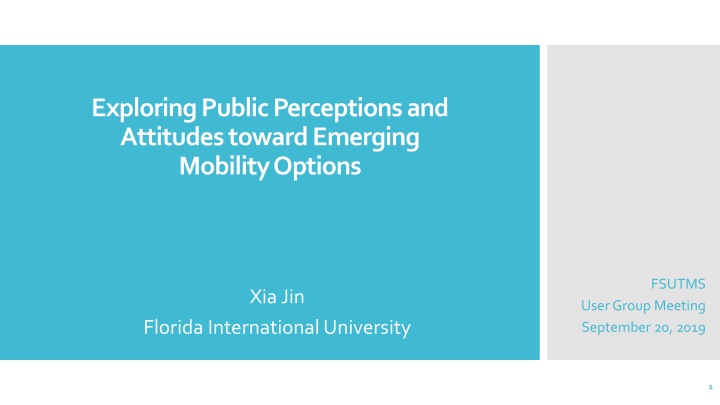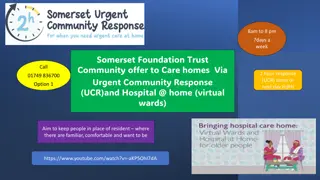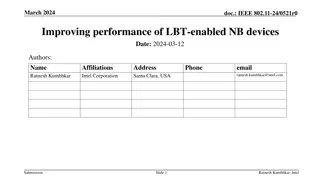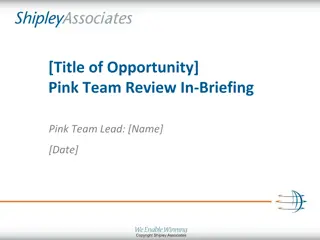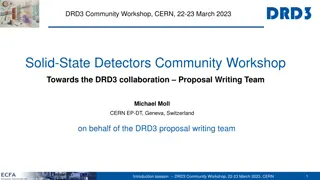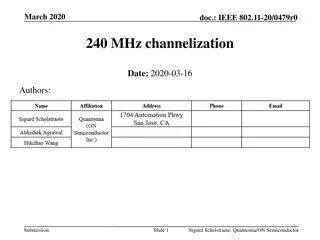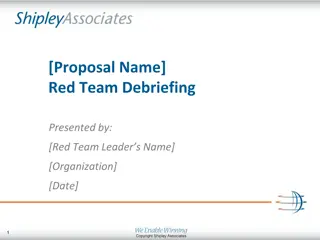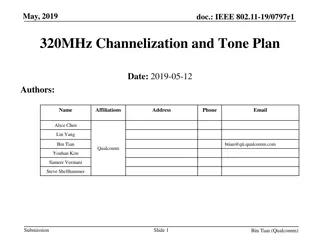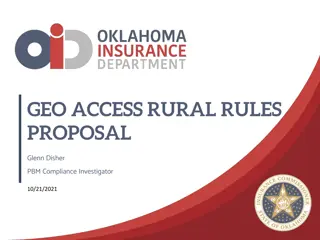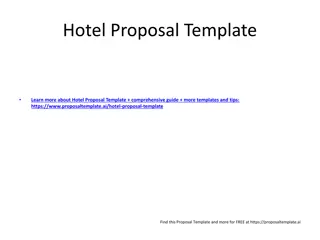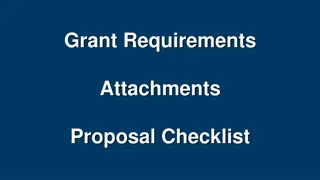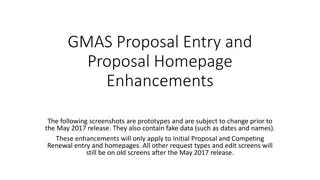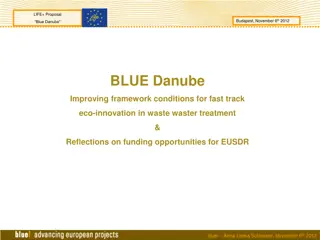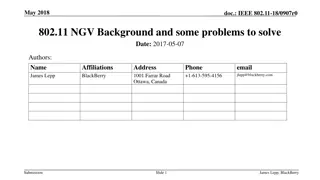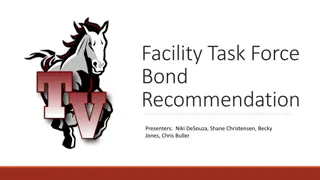Response to Re-channelization Proposal
This document is a response to a re-channelization proposal related to IEEE 802.11 technology, discussing the compatibility with DSRC services and advocating for a different approach. The authors highlight concerns and suggest focusing resources on developing a proposal that better protects DSRC services.
Download Presentation

Please find below an Image/Link to download the presentation.
The content on the website is provided AS IS for your information and personal use only. It may not be sold, licensed, or shared on other websites without obtaining consent from the author.If you encounter any issues during the download, it is possible that the publisher has removed the file from their server.
You are allowed to download the files provided on this website for personal or commercial use, subject to the condition that they are used lawfully. All files are the property of their respective owners.
The content on the website is provided AS IS for your information and personal use only. It may not be sold, licensed, or shared on other websites without obtaining consent from the author.
E N D
Presentation Transcript
Exploring Public Perceptions and Attitudes toward Emerging Mobility Options FSUTMS Xia Jin User Group Meeting September 20, 2019 Florida International University 1
Objectives Investigate adoption and willingness to pay (WTP) of Autonomous Vehicles (AV); Based on a nationwide survey in the United States; With special emphasis on the role of personal attitudes and preferences; Through a structural equations model (SEM) to address endogeneity. 2
Research Question AV Adoption and WTP Q: I see myself driving/riding in these vehicles in ten years. Basic vehicles (the driver is in complete and sole control of the primary vehicle functions) Advanced features (such as, adaptive cruise control, lane centering, crash warning, etc.) Partial automation (allows the vehicle to take over only under certain conditions and returns control to the driver when conditions change) Full automation (allows the vehicle to take over all driving functions for an entire trip) Q:I m willing to pay $___ more for these features a) 500 b) 1000 c) 1500 d) 2000 e) 3000 f) 4000 g) other______ 4
Adoption WTP by Vehicle Feature $4000 and up $3,000 100% 90% 12% 36% 80% 15% 70% $2,000 60% $1,500 50% 40% 37% $1,000 30% 20% $500 10% $0 0% Basic vehicles Advanced features Partial automation Full Basic vehicles Advanced features automation Partial automation Full automation AV Adoption and WTP 5
Survey Questions on Attitudes Mobility Preferences Perceptions of Ridesourcing Services Reasoning for Vehicle Ownership Views toward Automated Vehicle (AV) Technologies 7
Personal Attitudes New Technology-Would like to learn about and use new New Technology-Regularly use smartphone apps New Technology-Highly engaged in online activities Multitasking- Prefer multitasking on my trip Multitasking-Prefer doing one thing at a time Shared Mobility- Increase quality of my life Shared Mobility-Traveling by myself is much more convenient Shared Mobility-Hardly trust to travel with strangers Shared Mobility-Save on my expenses Service Quality-Choose a transportation option that is the Service Quality-Transportation option must have the Service Quality-Choose fastest and easiest way to travel Driving is stressful I enjoy driving Negative Indifferent Positive 0.0% 25.0% 50.0% 75.0% 100.0% 8
Principal Component Analysis A dimension reduction technique Describe variability among a large set of observed, correlated variables by shrinking the computational space into a lower number of hidden (latent) factors. 9
Factor 3 Travel with Strangers Coeff Factor 1 Joy of Driving Factor 2 Choice Reasoning Factor 4 Tech Savvy Coeff 1.00 Coeff Coeff I enjoy driving Driving in traffic congestions is stressful. When going somewhere, I want to do so in the fastest and easiest way and am willing to use any transportation option to achieve this. My transportation option must have the functionality to meet my traveling needs and lifestyle My total cost when going somewhere needs to be low, and I will choose a transportation option that is the cheapest. I believe that shared transportation services can help me save on my expenses. I hardly trust to travel with strangers. Driving 1.00 1.62 Service Quality 1.28 1.30 1.44 1.00 Shared Mobility Traveling by myself (or with people I know) is much more convenient than with strangers. 1.55 On-demand services increase quality of life. I prefer doing one thing at a time. I prefer multitasking on my commute trip if possible. I consider myself as highly engaged in online activities (e.g. social networking, following news, and searching information, etc.). I regularly use smartphone apps to facilitate my daily errands (online transactions, navigation, and checking emails, etc.). I would like to learn about and use new technologies in my life. 1.43 0.84 Multi-tasking 1.00 1.25 New Technology 1.36 1.15 10
STRUCTURAL EQUATIONS MODEL 11
Provides a simultaneous estimation of multiple correlated decisions Allows the user to incorporate latent (unobserved) constructs into the model structure Methodology The Structural Equation establishes the causal effects between endogenous variables (variables to be predicted) and their predictors (either as observed exogenous variables or latent factors) The Measurement Equation describes how well the latent factors are explained through personal attitudinal indicator 12
Adoption Coeff 0.703 0.091 -0.927 WTP Z Coeff Z Full automation Partial automation Advanced features Age 50-54 Age 55-59 Age 60-64 Age 75 or older High school graduate Black/African American Full time student Other 0-25k 25-50k 50-75k CHSI_Private Vehicle Driver CHSI_Private Vehicle Passenger Parking time: 15-20 mins Online shopping Rideshare experience Driver s license F1 Joy of Driving F2 Choice Reasoning F3 Traveling with Strangers F4 Technology Savviness 4.73 0.148 -6.18 -0.434 -2.36 -0.285 0.305 -2.55 2.56 Age -0.697 -2.1 Education Ethnicity -0.23 -2.99 0.424 0.483 0.501 -1.114 -0.733 -0.49 2.79 2.53 2.59 -6.94 -6.14 -4 Employment -0.433 -0.207 -4.21 -2.34 Income -0.065 -0.102 -1.171 -2.82 -3.12 -2.68 Habits Current Mobility Profile 0.136 0.303 4.4 2.91 Personal Attributes -0.331 -0.489 -2.91 -4.11 -2.46 2.052 1.106 -2.89 3.92 2.37 Latent Attitudinal Factors 0.56 0.482 6.57 9.69 Covariance Goodness of fit measures ?2 13 N=1198, ?2=1588.239, df=697, ?? = 2.27, RMSEA=0.033
Adoption Coeff -0.489 -4.11 WTP Z Coeff -2.46 -2.89 2.052 1.106 Z F1 Joy of Driving F2 Choice Reasoning F3 Traveling with Strangers F4 Technology Savviness Attitudinal Factors 3.92 2.37 0.56 6.57 14
Summary The SEM approach revealed four major latent attitudinal factors, representing joy of driving , mode choice reasoning , traveling with strangers , and technology savviness . Further research might assess the interaction effects between attitudes and socio-economic demographic attributes. 15
Questions? Xia Jin, Ph.D., AICP Associate Professor Thank you! https://behaviorlab.eng.fiu.edu Florida International University Tel: (305)348-2825 E-mail: xjin1@fiu.edu 16
